5.16 Virtual IP Address
You can configure a virtual IP address by using Novell Remote Manager or INETCFG.
5.16.1 Using Novell Remote Manager
-
Log in to Novell Remote Manager, then click Configure TCPIP > Start TCP/IP Configuration > Configure Boards > Add.
The Select a Driver window is displayed.
-
Click the VNIC link under Board Name.
The New Board Configuration [VNIC] window is displayed.
Figure 5-16 New Board Configuration [VNIC] Window
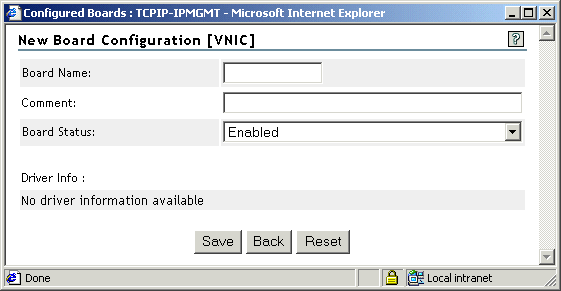
-
Specify a board name, then click Save > Save to save your changes and return to the TCP/IP Configuration Menu window.
-
Click TCP/IP to interface Bindings > Add.
Figure 5-17 Select a Configured Network Interface Window
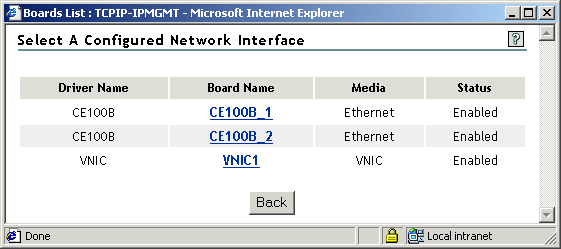
-
In the Select a Configured Network Interface window, click the VNIC board_name entry under Board Name.
Figure 5-18 Binding TCP/IP to Virtual Interface Window
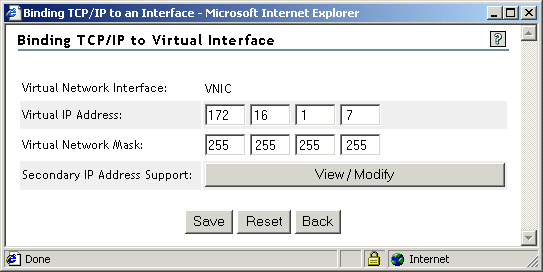
-
In the Binding TCP/IP to Virtual Interface window, type a virtual IP address and a virtual subnet mask.
-
Click the View/Modify button to the right of Secondary IP Address Support.
Figure 5-19 Secondary IP Address Configuration of VNIC Interface Window
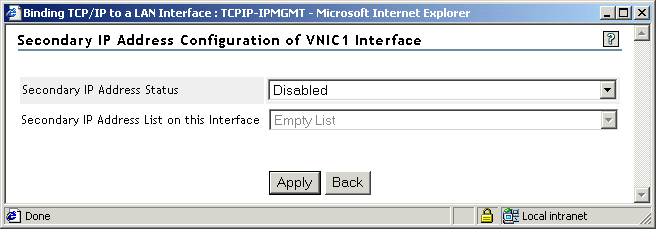
-
In the Secondary IP Address Configuration of VNIC Interface window, set Secondary IP Address Status to Enabled, then click the Add button to the right of Secondary IP Address List on this Interface.
Figure 5-20 Secondary IP Address Configuration Window
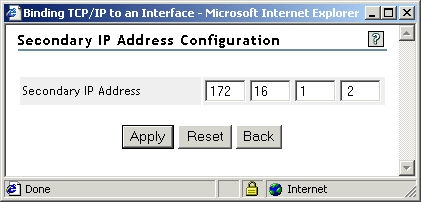
-
In the Secondary IP Address Configuration window, type a secondary IP address.
-
To save your changes and return to the TCP/IP Configuration Menu window, click Apply > Apply > Save > Back.
-
If you want these changes to take effect immediately, click Reinitialize Options.
5.16.2 Configuring Outbound VIPA Support
You can configure Outbound VIPA Support if you have any Virtual IP Address (VIPA) configured and if there are any TCP/UDP client applications, which issue requests to remote servers with wildcard source addresses through this interface.With this option enabled, all TCP/UDP client request packets will have their source IP address field set to the primary virtual IP address. However, enabling this option forces TCP/IP to use the primary virtual IP address as the packet's source IP address.
You can enable Outbound VIPA Support at either the system level or the interface level.
At System Level
-
Click Configure TCPIP > Start TCP/IP Configuration > Configure TCP/IP.
-
In the TCP/IP Protocol Configuration window, set Outbound VIPA Support to Enabled.
-
To save your changes and return to the TCP/IP Configuration Menu window, click Save > OK.
NOTE:Enabling this option forces TCP/IP to use the primary virtual IP address as the packet’s source IP address.
At Interface Level
-
Click Configure TCPIP > Start TCP/IP Configuration > TCP/IP to interface Bindings > an existing binding.
-
Click the View/Modify button to the right of Configure TCP/IP Bind Options, then the View/Modify button to the right of Expert TCP/IP Bind Options.
-
In the Expert TCP/IP LAN Options of board_name with IP Address IP_addresswindow, set Outbound VIPA Support to Enabled.
-
To save your changes and return to the TCP/IP Configuration Menu window, click Apply > Save > Back.
IMPORTANT:When you set this option at the interface level, it is effective only if Outbound VIPA Support is enabled in the TCP/IP Protocols Menu window as well.
5.16.3 Using INETCFG
-
Load INETCFG, then select Board - Add a Virtual NIC Driver.
-
Select Bindings - Bind a Virtual IP Address to the Virtual Interface.
-
Press Esc until you are prompted to save your changes, then select Yes.
-
If you want these changes to take effect immediately, select Reinitialize System > Yes.